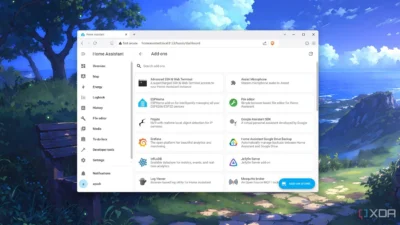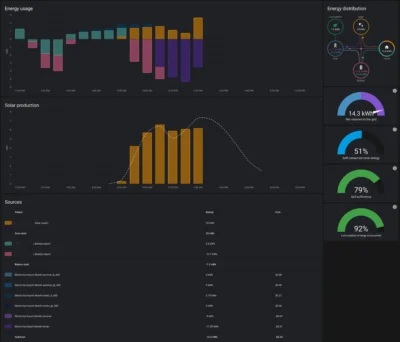3 Likes
1 Shares

There’s a new voice assistant in town, and this one can work locally in your home without phoning home to its corporate overloads. This week, the popular hobbyist smart home platform Home Assistant officially launched its first voice assistant hardware — Home Assistant Voice Preview Edition.
Built for the open-source smart home platform, Voice PE costs $59 and brings a locally controlled, privacy-focused voice assistant to Home Assistant in a plug-and-play package. Once connected to Home Assistant, you can use voice to control any connected device, with commands such as “Turn on the living room lights,” “Lock all the doors,” “Create a timer for 5 minutes,” and many more.
There have been other solutions before, but they were not so reliable, and of course the Google or Amazon based ones require the cloud access of these companies, and many do not like to have that channel open.
This is a hardware device (that does look pretty good) and seems to be pretty versatile. I think it could be well worth it, as long as it will get ongoing updates and not be replaced with some new model in the short term. Despite that, seeing it works fully offline, you should at least find it won’t ever be bricked or turned into a paper weight.
See theverge.com/2024/12/19/243251…
#Blog, #homeassistant, #privacy, #technology
Na - wer erkennt den #Film anhand seiner Energiesignatur?
Das ist von meiner smarten #Steckdose in #HomeAssistant, da bin ich noch Herr über meine eigenen Daten.
Da ich eine PV-Anlage habe, werde ich vermutlich demnächst einen #SmartMeter bekommen. Auch wenn der eine Menge Rauschen von anderen Geräten haben wird, würde ich nicht ausschließen, dass der VNB oder andere Interessierte mit entsprechenden Algorithmen einiges über mein Leben erfahren. Bin nicht so begeistert, aber ich sehe auch Chancen. Also alles wie immer eigentlich...
Seit 14:45 läuft der Recorder von #HomeAssistant gegen #PostgreSQL 16. Die Containerlandschaft wächst und gedeiht.
Meine ersten Tests mit #HomeAssistant und #Zigbee waren Standalone im Sommer mit BindMount auf dem Notebook mit #Podman und #sqlite.
Dann wurde der Rotz unverändert auf den 24x7 Server geschoben mit getunneltem SSH.
Dann Integration in die sonstige Containerlandschaft mit Anbindung an Internetz mit #nginx ReverseProxy.
Bis dahin alles gut. Nun habe ich bei der Migration von 'BindMount' zu regulärem Volume scheinbar den gesamten Datenbestand der sqlite verloren. Backup hätte ich, aber es waren nur ein paar Wochen.
Da ich eh noch auf ein echtes #RDBMS umstellen muss, werde ich wohl auf die Daten verzichten. Kein Bock, da lange nach der Ursache zu recherchieren. Vermutlich würde ich spätestens bei dem letzten Schritt doch wieder die Daten verlieren.
Irgendwas is ja immer...
Meine heutige Tagesleistung war, die heimische Containerlandschaft hinsichtlich #Netzwerkisolierung abzusichern und #HomeAssistant in podman-compose zu integrieren. Damit ist das Ding jetzt quasi von aussen erreichbar, neben der privaten #Nextcloud.
Als dezentes Zeichen für den Erfolg habe ich einen LED-Strahler im #Arbeitszimmer blau gefärbt. Soeben kam die beste Ehefrau von allen nach dem #Gassigehen auch zu mir, aber sie hat es noch nicht mal realisiert.
Ich prangere das an!

Käffchen und mal 5 Minuten Ruhe, um die Tibberdaten per Grafana in HomeAssistant einzubinden.
War deutlich einfacher als gedacht und ist hypsch übersichtlich..
Eigentlich sollte ich nicht überrascht sein, aber trotzdem: Autsch!
Die neuen, smarten #Steckdosen können auch die #Leistung messen. Auf dem #Schreibtisch habe ich drei #Monitore ca. 26'', zwei davon liefen für eine kurze Session von einer halben Stunde und zogen dabei 55 Watt! Der dazugehörige PC hängt übrigens nicht an dieser Dose.
Und nach der Session habe ich die Steckdose nicht gleich abgeschaltet, dabei zogen sich die Monitore im #Standby auch noch mal 2 bis 3 Watt. Alta!
Gut, dass die Steckdosen smart sind und ich zumindest eine Zeitsteuerung vornehmen kann, dass der ganze Rotz wenigstens nach Feierabend komplett aus ist. Aber während der Arbeit muss ich mir schon genauer überlegen, wann ich die volle Anzahl Monitore benötige.
#StromSparen #Stromverbrauch #Strom #HomeOffice #Energiesparen #Smarthome #HomeAssistant
Ich habe heute vermutlich 10 mal die Deckenbeleuchtung im frisch renovierten #Arbeitszimmer eingeschaltet. Die teuren LEDs von #Paulmann sind in zwei Reihen geschaltet für rechten und linken Teil des Raumes.
Heute hat sich die rechte Reihe nach dem 10. Einschalten entschieden, ein paar mal per #Blinken eine Re-Initialisierung anzuzeigen und danach konsequent die eingestellte #Lichtfarbe von #kaltweiß auf #warmweiß zu ändern. Also zurück auf Default. Nur rechts.
Ist bestimmt die eingebaute Erinnerung, dass ich noch Szenen in #HomeAssistant anlegen soll, um die jetzt nicht wieder alle einzeln nachjustieren zu müssen.
Danke, Paulmann.

Home Assistant is an incredible platform that reduces the complexity of managing all your smart appliances. From its remote monitoring features to compatibility with most smart gadgets and IoT devices, Home Assistant can turn any dull living space into an automated fortress.
What’s more, it has a robust list of integrations and add-ons, and you can even add more plugin repositories to take your smart home setup to the next level. But since it can get tough to sift through the barrage of integrations on the web, XDA Developers has compiled a list of the best plugins for most users.
There are actually a mass of plugins available for HA, especially if you include the HACS ones. HA Can be one of the more useful services in the home. There are one or two in this list that I’ll also be trying out.
See xda-developers.com/best-add-on…
#Blog, #homeassistant, #selfhosting, #technology
Bin wohl in der Smarthome-Hölle angekommen. Hatte zuerst eine #AqaraH2 gekauft und mit #Homeassistant getestet. Weil die das tat, was ich benötigte, dann noch mal zwei weitere nach kurzer Zeit bestellt und verbaut.
Nun sehe ich, dass ich alle schalten kann und auch alle die aktuelle Leistung des Verbrauchers anzeigen, aber nur bei der ersten wird auch der #Stromverbrauch angezeigt. Bei den neueren bleibt der Wert bei 0 kWh kleben.
Und die Temperatur wird bei keiner korrekt angezeigt, alle bei 0 °C.
Interessant ist, dass die neueren eine Firmware-Revision weiter sind, aber weniger können.
Soll das so?
Bin fast fertig und kann eigentlich aufhören, oder? Die smarte #Steckdose #AqaraH2 ist angeschlossen und per #Zigbee vom Server mit #HomeAssistant aus dem Nebenraum erreichbar. Sie ist schaltbar und sagt mir, wie viel #Strom verbraucht wird.

My solar system also only reads its full power usage without seeing what power is going direct to the geysers. In my case, I’m using a Hall sensor with an Efergy cloud based system to read the power that is still being drawn from the grid.
In the USA, most smart meters send data along the ISM band, in a protocol called Encoder Receiver Transmitter, by Itron corporation. This applies to electric, gas, and water meters. Said protocol has a variety of message formats, but they’re all fairly easy to work with. The meters generally have a barcode or similar tag on them, usually near the word/logo for “Itron”, with an 8 digit numeric ID.
A Software defined radio (SDR) can be put to good use though to read this data into Home Assistant though. This project explains how that can be done.
See pdx.su/blog/2024-03-17-reading…
#Blog, #homeassistant, #smarthome, #technology
Ich find den Artikel ja durchaus interessant und #HomeAssistant kommt auch in die nähere Auswahl. Aber irgendwie werde ich immer skeptisch, wenn die Dokumentation aus Screenshots besteht, die jemand mit dem Smartphone vom Linuxdesktop abfotografiert hat - mit sich selbst schemenhaft im Spiegelbild.
Naja, ich seh's mir trotzdem mal an...
Unser Zweit-Kühlschrank hat eine Macke, und zwar hört er ab und an, die letzen 3 Wochen vielleicht 3 mal, auf zu kühlen.
Als Feierabendbiertrinker bemerke ich das zwar, aber Monitoring by Biertrinktemperatur ist fehleranfällig, zumal man eigentlich 24/7 trinken müßte.
Der Kühlschrank erholt sich wieder, wenn man ihn einen Tag (möglicherweise auch kürzer, ich habs nicht getestet) vom Strom nimmt.
Irgendwann werden wir ihn ersetzen müssen, aber nicht demnächst.
Um also die Leber zu entlasten, muß ein Monitoring her, natürlich mit Alarmierun, Eskalationen und dem ganzen Zinnober.
#Zabbix!
Heute kam das Thermometer, ich habe schon lange eine Wetterstation, an die ich mehrere Sensoren für Temperatur und Luftfeuchtigkeit anknüppern kann.
Gemacht, getan, jetzt nur noch die Temperatur auslesen.
Das kann zwar lokal bleiben, dann habe ich aber nur eine Anbindung an Home Assistant. Vermutlich könnte ich Zabbix auch an Home Asstant anflanschen, aber einfacher gehts über die API im Internet:
#!/bin/bash
/usr/bin/curl -s \
'https://api.ecowitt.net/api/v3/device/real_time?application_key=[…]&api_key=[…]&mac=[…]&call_back=all&temp_unitid=1' | \
/usr/bin/jq -r .data.temp_and_humidity_ch8.temperature.value
Funktionert:
❯ ./wetterstation.hwr.eisfach-temperatur.sh
-14.7
Jetzt nur noch ein Item basteln in Zabbix:
Und den entsprechenden Trigger, der bei einer Temperatur gleich oder über -15°C auslösen soll:
Einbiegen auf die Zielgerade, wir brauchen ja noch die Benachrichtigung:
Und nun nur noch, wer auf welchem Wege alarmiert werden soll: ich.
Funzt!
Und wenn wir schon dabei sind: #Grafana!